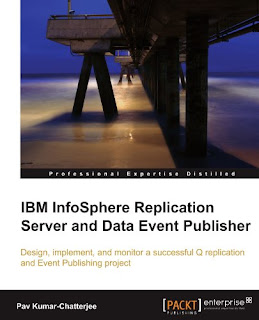IBM InfoSphere Replication Server and Data Event Publisher
Monday, August 12, 2013
Business planning is no longer just about defining goals, analyzing
critical issues, and then creating strategies. You must aid business
integration by linking changed-data events in DB2 databases on Linux,
UNIX, and Windows with EAI solutions , message brokers, data
transformation tools, and more. Investing in this book will save you
many hours of work (and heartache) as it guides you around the many
potential pitfalls to a successful conclusion.
This book will accompany you throughout your Q replication journey.
Compiled from many of author's successful projects, the book will bring
you some of the best practices to implement your project smoothly and
within time scales. The book has in-depth coverage of Event Publisher,
which publishes changed-data events that can run updated data into
crucial applications, assisting your business integration processes.
Event Publisher also eliminates the hand coding typically required to
detect DB2 data changes that are made by operational applications.
We start with a brief discussion on what replication is and the Q
replication release currently available in the market. We then go on to
explore the world of Q replication in more depth. The latter chapters
cover all the Q replication components and then talk about the different
layers that need to be implemented-the DB2 database layer, the
WebSphere MQ layer, and the Q replication layer. We conclude with a
chapter on how to troubleshoot a problem. The Appendix (available
online) demonstrates the implementation of 13 real-time Q replication
scenarios with step-by-step instructions.
Publish changed data events in order to operate updated data into
critical applications, thus helping your business integration processes
with this professional guide
Design, implement, and monitor a successful Q replication and Event Publishing project
Covers the toolsets needed to implement a successful Q replication project
Aimed at the Linux, Unix, and Windows operating systems, with many concepts common to z/OS as well
A chapter dedicated exclusively to WebSphere MQ for the DB2 DBA
Detailed step-by-step instructions for 13 Q replication scenarios with troubleshooting and monitoring tips
Written in a conversational and easy to follow manner
What you will learn from this book
Use Q replication to feed a data warehouse and explore the way it
interacts with the DB2 High Availability Disaster Recovery (HADR)
function
Master the main phases of the DB2 database layer, the WebSphere layer,
and the Q replication layer, which make up a Q replication solution
Create and configure the control tables required by Q replication, and
quickly examine how the Q replication components communicate from a DB2
perspective
Set up a Q replication and Event Publishing environment
Administer a Q replication and Event Publishing environment
Troubleshoot an existing Q replication and Event Publishing environment
Implement 13 Q replication scenarios, ranging from the unidirectional
replication to peer-to-peer, with step-by-step instructions
Password: Antarctic



0 comments:
Post a Comment